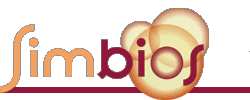|
|
Dissemination of Research Results Highlights of past courses, symposiums and workshops The potential user community for the software produced by Simbios, and available from Simtk.org is very large. Our initial set of Driving Biological Problems (DBP) demonstrates the breadth of problems for which physics-based modeling and simulation are critical. The RNA folding DBP includes RNA biologists, physical chemists, physicists, molecular biologists, and biochemists. The myosin dynamics DBP includes biochemists, biomechanical engineers, geneticists, chemists, biophysicists, and structural biologists. The neuromuscular dynamics DBP includes orthopedic surgeons, biomechanical engineers, neurologists, and physical therapists. The cardiovascular fluid dynamics DBP includes vascular surgeons, cardiologists, vascular biologists, and bioengineers. We are convinced that these users will provide appropriate "pull" on SimTK to ensure that it has relevant and useful capabilities. Please visit http://simtk.org to view our progress on SimTK. Our dissemination plan uses both traditional and novel channels to ensure that the fruits of our efforts are properly disseminated to the scientific, engineering and lay community.
Biomedical Computation Review As part of the dissemination effort of Simbios we publish a new quarterly magazine, Biomedical Computation Review. The purpose of this magazine is to disseminate new discoveries and resources to the biomedical community. While the scope of Simbios is on physics-based simulation of biological structures, we are covering the broader area of biomedical computation with the Biomedical Computation Review, with a focus on cross cutting issues that are important to and give identity to this entire community. Although originally envisioned as a newsletter, we have taken the initiative to turn our new publication into a full magazine (quarterly, in print and online, both free of charge). Please visit Biomedical Computation Review to view and download past and present issues, or to request a free subscription. Training Biocomputational Scientists Stanford has a strong track record in training graduate students and post-doctoral fellows. We have access to training grant support and training programs across all the disciplines contributing to this Center. Stanford has a tradition of equipping biomedical computation students and post-doctoral fellows with a broad set of tools, so that they are prepared to approach unanticipated research challenges that may arise in the future. The main focus of our proposal in training, therefore, is to fully participate in and augment our existing programs with courses that are specifically geared towards the intellectual domain of physics-based simulation. These courses will strengthen existing training programs in Bioengineering, Biomedical Informatics, Computer Science, Electrical Engineering, Biomechanical Engineering, and Structural Biology from which students on this project will be drawn. In the context of existing courses, seminars, and community building activities, we will be well positioned to continue being a leader in the general education of biomedical computation scientists.
Additionally, Simbios launched the OpenMM Visiting Scholar Program in 2012. Each year, meritorious scholars from other institutions are accepted to visit Simbios for one month. During this time each scholar has the opportunity to work directly with our faculty and software developers on their project. For information, visit the OpenMM Visiting Scholar Program page. For a list of previous OpenMM Visiting Scholar awardees, click here. Summer Internships In our collaboration with San Francisco State University (SFSU), an underrepresented minority-serving institution within the California State University System, each summer we engage selected SFSU computer science students to work on our software engineering research projects. These projects are win-win situations. The students gain valuable experience with real software engineering problems, while Simbios benefits both directly from the work performed by the students and indirectly by introducing the students to the field of biocomputing.
Potential candidates are first interviewed by Dr. Dragutin Petkovic of SFSU, followed by interviews with Simbios staff. Each student is assigned a Simbios mentor and spends the summer working on a project. The students present their work to Simbios staff, faculty, and students at the end of the assignment. For a list of previous Simbios summer interns and their projects, click here. |
|



